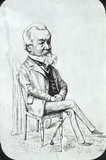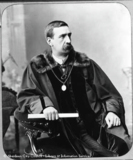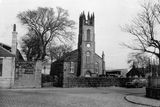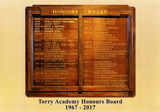|
Quick Search
|
Search Results
You searched for: More Like: 'Allenvale Cemetery from Kincorth'
28 items
items as
Great Southern Road
859 In 1880, Miss Elizabeth Crombie Duthie of Ruthrieston bought land at Allenvale and Polmuir and the vacant estate of Arthurs Seat and donated it to Aberdeen Town Council as a public park. Today, the park covers 44 acres of wide open spaces. A restaurant was also opened in 1972 at a cost of £50,000 and the famous winter gardens built in 1899 at a cost of 1550 pounds and subsequently rebuilt in 1969 at a cost of £58,000. In the centre of the picture can be seen the old West Lodge or Duthie Lodge. When the Great Southerrn Road and King George VI Bridge were built in 1938, the lodge was bought for 60 pounds by an Aberdeen contractor, dismantled and moved piece by piece to Rubislaw Den South. The Great Southern Road was a new road from Holburn Street to Whinhill Road, linking the city with the new satellite town at Kincorth and onwards to meet the Aberdeen - Stonehaven Road. Culter War Memorial
994 A photograph showing the unveiling of a new panel at Culter War Memorial on Sunday 19th June 1949.
The article 'Tribute to War Dead of Culter' from the Press & Journal of 20th June 1949, page 6, describes the ceremony as follows:
"A panel containing the names of 29 men from the parish who lost their lives in the recent war was unveiled at Culter War Memorial yesterday.
"Relatives of the fallen and representatives of the Boys' Brigade, Girl Guides, Brownies, and the Territorial Army were grouped round the memorial as Mrs Tough, Hillside Road, Culter, who lost two sons in the war, unveiled the tablet.
"The panel was dedicated by the Rev. J. R. Dey, Kelman Memorial Church, who, along with the Rev. T. W. Howie, St Peter's Church, conducted the service"
Culter War Memorial is a tapering, crenelated tower located on a hillock to the west of the village. It is accessed by a footpath that leaves North Deeside Road not far beyond the bridge over the Culter Burn.
Correspondent Brian Coutts has been in touch to inform us that one of the representatives of the Brownies present at the ceremony was Elizabeth McNab.
The abovementioned sons of Mrs Jane Tough of Hillside Road were Driver Frank Tough, Royal Corps of Signals, formerly an employee of Culter Paper Mills, who was killed by enemy action in the Middle East on 24th September 1942, aged 24, and Private Ernest "Ernie" Tough, 2nd Gordons, who died on 5th October 1943, aged 26, while a prisoner-of-war in Thailand. (Source: Press & Journal, 26th September 1946, page 3.)
The former, Frank Tough, is buried at Alexandria (Hadra) War Memorial in Egypt and Ernest is buried Thanbyuzayat War Cemetery in Myanmar. (Source: Commonwealth War Graves Commission website.) Settmaker at Persley Quarry
1071 The Aberdeen area had many granite quarries, and there was a need for men who had the skill to reduce huge blocks of granite into manageable pieces by chipping it with a variety of hammers, and chisels to produce the required shape and size. In this 1920's photograph we see a settmaker at Persley Quarry on the north side of the River Don in Aberdeen, at his wooden shelter or 'skaithie'. These shelters provided some sort of wind break for these men who had to sit on blocks of granite patiently working on the hard stone. Settmakers made cassies for roads and Aberdeen setts were used to pave streets in London. On his left is a tripod structure which acted like a small crane to lift the bigger stones into position. Note the lack of protective safety equipment apart from some extra padding on his knees. Brae Farm
1790 This photograph was taken in 1951 by James Kellas and looks east showing, on the left, the rear of Brae Farm, located on Morningside Road, and part of 142 Morningside Avenue on the right.
There was originally a Brae Farm to the north west of this location that can be seen the Ordnance Survey map published in 1869 (Aberdeen Sheet LXXV.14). Just to the north of the old farm on the map is a single Aberdeen Water Works reservoir.
An article from The Leopard magazine by Diane Morgan (October/November 1985) explains that in 1885 an Aberdeen Corporation Water Act was passed to empower the Town Council to take eight million gallons daily from the River Dee and to build a second reservoir at Mannofield. This was to keep up with the city's rapid population increase.
To carry out the expansion, the council acquired the land adjoining the initial reservoir including the first Brae Farmhouse and its steadings. They then became known as Reservoir Cottage and Reservoir House and served as the home of the inspector of the water works. A relatively early inspector was called William Clark. On 28th February 1898 he died at the cottage aged 64. He was buried in the John Knox Churchyard (Aberdeen Weekly Journal, 02/03/1898, p.4).
Clark was likely succeeded as waterworks inspector by James Forsyth. The Forsyth family lived at the cottage well into the 20th century. James was married to Margaret (née Jaffray), who died after him on 28th July 1945, aged 85. Their second son, Sapper John Forsyth, died aged 26 at Oldmill Military Hospital on 20th April 1917. He was buried at Springback Cemetery.
The reservoirs continue to play a vital role in supplying water to Aberdeen. The cottage and house however were demolished in the late 20th century and replaced by modern water treatment buildings.
As shown on the 1901 OS map, sometime shortly after the passing of the 1885 act the Brae Farm we can see in this picture was built to the south east, where Morningside Road met Auchinyell Bridge. To the east, Aberdeenshire County Cricket Ground was also built around the same time.
This later Brae Farm was the home to the Kinnaird family for the first half of the 20th century. The heads of the family were Frank Kinnaird and Margaret Amelia Smith.
Their son Lance-Corporal A. G. Kinnaird, of the Royal Scots, was reported as a prisoner of war in Germany in June 1918. Prior to the war he had worked with the Clydesdale Bank (Evening Express, 03/06/1918 p.3).
Frank's eldest daughter, Jessie Sinclair, married James Smith Mathieson at Ruthrieston U.F. Church on 7th September 1927 (Evening Express, 08/09/1927, p.6).
A younger daughter, Edith Kinnaird, married a man from Portsmouth called Andrew Livingstone in July 1936. The marriage took place in Ruthrieston West Church and the reception was at the Caledonian Hotel (Press & Journal, 06/06/1936 p.8).
Daughters Amelia Elizabeth and Margaret Kinnaird both left Brae Farm in the 1920s (1924 and 1920, respectively) to reunite with fiancés who had travelled ahead to Canada.
Frank Kinnaird died on 12th August 1950, aged 84.
At some point during the 1930s-1950s the residential streets we know today, Morningside Avenue, Terrace and Place were constructed between the reservoir and the new farmstead. These streets take their name from Morningside Farm to the east. As can be seen in this photograph, the farm stood into the 1950s. It was eventually demolished when Morningside Avenue was extended to meet Morningside Road. The newer bungalows can be distinguished by their tiled, rather than slated roofs. Beech-hill Farm
1793 A photograph by James Kellas from the early 1950s, looking north, showing Beech-hill Croft behind allotment gardens. The croft and attached farm were located west of Springbank Cemetery, across Springfield Road.
(Many thanks to A. G. Duthie for identifying the location). Hatter to the People
2021 A drawing of Samuel "Sammy" Martin, who was known as 'the hatter to the people.' His shop was located at 34 Union Street. William Skene, in East Neuk Chronicles, describes Martin as "one of the most ultra-loyal subjects Her Majesty ever had in these parts." On special occasions he would dress in a red Garibaldi shirt and fancy head dress and play the cornet from the windows of his shop. He was something of a pioneer in local promotion. He is buried in Nellfield Cemetery and his tombstone reads "The last resting place of Samuel Martin, Hatter to the People." Lady Lyon
2034 Portrait of Elsie Inglis Lyon (1853-1927), Lady Lyon. She was the wife of Sir Alexander Lyon (1850-1926), who served as Lord Provost of Aberdeen from 1905-1908.
Lady Lyon was born and educated in Aberdeen. She was active in church work and schemes related to child welfare and maternity services. She served on the committee of the Aberdeen District Nursing Association for 23 years.
In August 1925 Alexander and Lady Lyon celebrated their golden wedding anniversary.
Lady Lyon died on 3rd December 1927, aged 74, in her home at 10 Queen's Road. This was seven months after the death of her husband. Her obituary is in the Press & Journal, 5th December 1927, page 8.
Her funeral took place on 6th December. She was buried in the family burial ground at Nellfield Cemetery. The funeral was reported on page 8 of the next day's Press & Journal. Baillie Rust
2063 A photographic portrait of Baillie John Rust (1853-1919). He was the son of John Rust and Margaret Henderson. His father founded the well-known timber merchants John Rust & Son in 1845.
John Rust junior was an architect and local politician. He served his architectural apprenticeship with John Russell McKenzie before going into business for himself with offices on Union Street, latterly number 224.
Rust was highly active in local life. He was elected to the Council in 1886 representing the Rubislaw Ward. He was re-elected in 1889 and promoted to the position of Third Ballie in 1890.
On the death of the incumbent, William Smith, Rust was a successful applicant for the post of city architect. On his appointment in March 1892 he retired his place on the Council. He served as city architect until his death in 1919.
Along with Sir Alexander Lyon and John Morgan, the builder, Rust was considered a moving spirit in the local government regime known as the "Young Party".
His Aberdeen Journal obituary highlights his involvement in the Beach Bathing Station scheme and the Union Terrace improvements. Also that he was a justice of the peace for Aberdeen City and Kincardineshire.
Moreover he was a significant property owner and was involved in local political, civic, military and church groups.
He died suddenly while on his way to work from his residence of Hawkshill, Milltimber. He was buried in Nellfield Cemetery. His Aberdeen Journal obituary can be found in the issue for 12th September 1919, page 6.
An entry for John Rust can be found in the Dictionary of Scottish Architects here A School of Dolphins: Kirky at Kincorth Library
2172 To represent the dolphin habitat, their shimmering skin and their bright, happy personalities every child in Kirkhill School made a glass tile with Shelagh Swanson from Oil and Glass to make Kirky a shiny and silky smooth sculpture Treasure 35: Notes and Jottings of G.M. Fraser
2323 George Milne Fraser had a lifelong interest and expertise in local history; delivering talks (as seen in the December 2015 Treasure), publishing books and numerous letters and articles in the local press. His 'Notes and Jottings' collection comprise over 70 volumes, mostly hand written (including a form of shorthand), which are a treasure trove of information about the local area.
Within these notebooks are newspaper articles and advertisements, photographs, personal correspondence, sketches and many other interesting bits and pieces. Library staff have compiled an index to this invaluable resource and consult it on a regular basis when researching enquiries. It is quite a challenge deciphering his handwriting sometimes!
As a journalist by profession, G. M. Fraser retained his talent for writing and contributed articles to the Aberdeen Free Press, Bon Accord and Northern Pictorial, Evening Gazette, and journals such as the Deeside Field.
His contributions to local literature began in 1904 with the publication of The Green. Historical Aberdeen appeared the following year and after Aberdeen Street Names in 1911 the Town Clerk Depute wrote to Fraser with the words "We must now regard you as our Principal Historian".
The Life and Work of G. M. Fraser
G. M. Fraser was appointed city librarian in 1899 and was the second public librarian in Aberdeen. He can be seen on the far right of this image from the library archive.
His name was known all over the north east and he was mentioned in the chorus of one of Harry Gordon's popular songs, The Auldest Aiberdonian: "I ken lots o' stories G. M. Fraser disna ken". On 30 October 1923 he gave a 15 minute talk on the radio about Castlegate, becoming the first librarian in Aberdeen to make a radio broadcast.
During his term of office there were many developments in the Library service:
- The Central Library was extended in 1905 to include a new reading room
- Branch reading rooms and delivery stations were established throughout the city
- The Juvenile Library in Skene Street opened in 1911
- Open access was introduced in the Lending Library 1925 (find out more about Open Access libraries in the October treasures!)
- Fraser's strongest legacy is the Local Studies collection, which still contains many of our treasures.
G. M. Fraser was remembered very fondly after his death on 7 June 1938. There were many tributes including one from the Library Committee. Perhaps one of the warmest tributes was paid by his successor as City Librarian, Marcus Milne:
"Somehow the Library and G.M. were one. You could not think of the Library without thinking of that kindly figure who was head of it; and one could not meet him without thinking of the building he graced for so long. Mr Fraser had 2 hobbies and work was both of them. He lived for nothing else. The library was ever uppermost in his thoughts and closely allied to his love for the Library was his great love for things Aberdeen".
Mr Fraser's funeral service was attended by many prominent city officials and floral wreaths included one from Lady Aberdeen with the inscription "In affectionate and grateful remembrance of a much valued friend". He is buried in Springbank Cemetery.
In 1955, Aberdeen's first post-war permanent branch library was opened at Northfield and named the G. M. Fraser Branch Library in his honour.
In further recognition of his contribution to the development of the Library service, a commemorative plaque can be found on the front of the Central Library building. Beach Rescue Lifeguard
2466 A photographic portrait of an unknown beach rescue lifeguard.
Correspondent Ed Fowler suggests the sitter may be Willie 'Moosie' Sutherland, an accomplished swimmer, diver, and local life-guard.
In Allenvale Cemetery, there is an ornate granite memorial to Sutherland made by Messrs Bower & Florence of the Spittal Granite Works. It has an inscription that reads: "Erected by public subscription in memory of William Sutherland, in recognition of his gallantry in saving upwards of 120 lives from death by drowning. Born at Aberdeen, 19th January 1845, died 20th September, 1885. A hero in humble life interred here."
Obituaries in the local newspapers state that Sutherland worked as an assistant in the City Surveyor's Office. He was formerly a slater and had become an excellent draughtsman. Between five and six hundred people are reported as in attendance at his funeral. Samuel "Sammy" Martin
2627 A photograph of Samuel Martin taken from East Neuk Chronicles by William Skene (1905). Martin was the self proclaimed "Hatter to the People" and a well known figure in his day. His hat shop was located at 34 Union Street. He died on Saturday 7th January 1888 and is buried in Nellfield Cemetery. A book about his life by Edward Ranson was published in 1996 called The Mad Hatter of Aberdeen: The Life and Times of Samuel Martin. St. Clement's Parish Church
2669 St. Clement's Parish Church, Footdee, c.1960. The history of St. Clement's dates from about 1498, when a chapel was built there principally for the fisher folk of Futtie.
This particular building was constructed in 1828 to a design by architect John Smith. A fine belfry, together with a boundary wall for the cemetery and area in front of the church complete the layout.
By the end of the 19th century, the district of Footdee was changing, with the population moving to other parts of the city. Today, the church is no longer in use, being surrounded by many oil-related commercial developments. The tall church tower is still however a landmark in the harbour area, as well as to individuals sailing into port. Torry Academy Honours Board 1927-1966
2745 A photograph of one of three boards from Torry Academy listing distinguished students.
Torry Academy opened in 1927 and closed in July 2018 after merging with Kincorth Academy to create a new school at Nigg called Lochside Academy.
As of July 2018 the honour boards are being stored in Torry Library. Torry Academy Honours Board 1967-2017
2746 A photograph of one of three boards from Torry Academy listing distinguished students.
Torry Academy opened in 1927 and closed in July 2018 after merging with Kincorth Academy to create a new school at Nigg called Lochside Academy.
As of July 2018 the honour boards are being stored in Torry Library. Torry Academy Year Four Honours Board 2000-2017
2747 A photograph of one of three boards from Torry Academy listing distinguished students.
Torry Academy opened in 1927 and closed in July 2018 after merging with Kincorth Academy to create a new school at Nigg called Lochside Academy.
As of July 2018 the honour boards are being stored in Torry Library. March Stone 3
3179 This stone is located against the cemetery wall at the corner of Nellfield Place and Great Western Road. It remains at this location in 2020. The large paving slabs seen here have been replaced by smaller paving blocks. It is marked '3 ABD'.
Kenndy's Annals gives the following description from 1698:
"Therefrae, to the houses at Cowperstown, where there is an sauser stone, two ells or thereby from the south-east gavel of the west most house."
In 1780 it is described as "a large earthfast stone in the North West corner of Mrs Cochrane's Parks of Ferryhill...".
Both this and the nearby number 4 stone are recorded on the Ordnance Survey 1868 large scale map of Aberdeen.
A slide of this image was kindly lent to Aberdeen City Libraries by Colin Johnston so that we could create a digital copy for public use.
The image was taken in the early 1980s when Colin worked as a teacher at Bridge of Don Academy. He led several current and former pupils, and staff members in an investigation into the location, physical condition and public knowledge of Aberdeen's historic boundary markers. Aberdeen Theatres: J. Scott Skinner
3394 James Scott Skinner (1843-1927) was a violinist and composer born in Banchory-Ternan. He was a regular performer on the stages of the North-East and beyond.
During his career he toured extensively including in North America. He performer as part of Walker & Company, the local cinema pioneers, and his playing was recorded many times.
Skinner was also a prolific and influential composer of violin music, particularly slow strathspeys. He wrote over 700 tunes, some of the most famous include The Bonnie Lass o' Bon Accord, The Cradle Song and The Miller o' Hirn.
He died on 17th March 1927 at his home at 25 Victoria Street, Aberdeen, after an exhausting tour of American. He is buried in Allenvale Cemetery. He wrote about his life in a book called My Life and Adventures.
This photographic portrait of James Scott Skinner is by Morgan of Aberdeen. Skinner stands dressed in formal Highland garb and holding his violin and bow. The image is the frontispiece of an edition of The Harp and Claymore. Underneath the photo his signature is accompanied by the quote "My age is a lusty winter, frostly but kindly". Rev. Robert Macleod
3806 A photographic portrait of Rev. Robert Macleod (c.1845-1927). He was the minister at John Knox United Free Church on Gerrard Street between 1883 and 1915.
Macleod was a native of Wick and was the father of J. J. R. Macleod, Nobel prize winning discoverer of insulin for the treatment of diabetes. Robert Macleod died in Edinburgh on 9th June 1927 and was buried in Aberdeen's Allenvale Cemetery. An obituary for him can be found in the Press and Journal of 10th June 1927, page 8.
This photograph is from a plate facing page 40 of a book of the bazaar held by Aberdeen City Libraries. The book is called Life of John Knox: with an account of John Knox Free Church and its Ministers. Issued in connection with Bazaar to be held in Music Hall Buildings, Aberdeen on Thursday, Friday, and Saturday 26th, 27th, 28th., 1899. (1899) Tourist information caravan
4213 A City of Aberdeen Council employee showing two tourists some local information.
This photograph was taken inside City of Aberdeen's tourist information caravan. Other images indicate this substantial caravan, when being moved, was towed by a gold coloured Range Rover.
The poster in the background for an event at Haddo House dates this image to 1980. A search of old newspapers suggests that a tourist information caravan had been in use since at least 1978 and probably earlier (Evening Express, 28th November 1985, page 9).
The caravan appears to have been sited at road-side locations for considerable periods. One location between 1978 and 1985, as is the case in this image, was the lay-by on the Stonehaven Road, across the A92 from the foot of Nigg Way, as the road approaches Aberdeen from the south.
The caravan's purpose was to provide information for visitors and would also have been able to assist with accommodation and activity bookings.
The photograph comes from a collection of slides donated to Aberdeen City Libraries by Aberdeen City Council's publicity department. Tourist information caravan
4215 A City of Aberdeen Council employee showing a visitor a map.
This photograph was taken inside City of Aberdeen's tourist information caravan. Other images indicate this substantial caravan was pulled by a gold coloured Range Rover.
Aberdeen City Council appear to have used a caravan like this from at least 1978. Its purpose was to provide information for visitors and would also have been able to assist with accommodation and activity bookings.
The caravan appears to have been sited at road-side locations for considerable periods. One location between 1978 and 1985 was the lay-by on the Stonehaven Road, across the A92 from the foot of Nigg Way, as the road approaches Aberdeen from the south.
The kitchen equipment seen here in the background would no doubt be useful when the caravan was in its location.
The photograph comes from a collection of slides from the 1970s and 80s donated to Aberdeen City Libraries by Aberdeen City Council's publicity department. Another image of the caravan suggests these ones may date from 1980. Tourist information caravan
4216 A photograph of the City of Aberdeen tourist information caravan at the lay-by on the Stonehaven Road, across the A92 from the foot of Nigg Way, as the road approaches Aberdeen from the south. The caravan was sited here between approximately 1978 and 1985. The houses on Clerk Maxwell Terrace can be seen in the background.
The image also shows public toilets that have been made available for travellers heading towards the city. In the foreground is a Ducati motorcycle loaded for travelling. The riders stand near the entrance to the caravan. In another image they are being shown information by a council employee.
Aberdeen City Council appear to have used a caravan like this from at least 1978. Its purpose was to provide information for visitors and would also have been able to assist with accommodation and activity bookings.
The photograph comes from a collection of slides from the 1970s and 80s donated to Aberdeen City Libraries by Aberdeen City Council's publicity department. Another image of the caravan suggests these ones may date from 1980. Cothal Mills
4292 A photograph looking north across the River Don towards the remains of Cothal Mills in June 1976. This image was likely taken not far from Dyce Cemetery.
Foxgloves can be seen in the foreground on the southern bank of the river. The buildings on the other side were part of a former woollen, yarn or flock mill complex.
The book Gordon: an illustrated architectural guide (1994) by Ian Shepherd, page 170, states that the mills, steam and water powered, once employed upwards of 100 workers and were superseded by the larger works downstream at Grandhome.
See Crombies of Grandholm and Cothal, 1805-1960: records of an Aberdeenshire enterprise (1960) edited by John R. Allan for more information on the use of the mills by the Crombie firm.
An entry for the mills in the Aberdeenshire Ordnance Survey Name Books, 1865-1871, reads as follows:
"A large pile of buildings situated close to the river Don. Originally there was a meal mill here and subsequently, when the greater portion of the houses were erected, the manufacture of woollen cloth was carried on; now yarn is the only production. Motive power water. Contiguous to the mill there are a considerable number of dwellinghouses inhabited by the mill workers. Property of Sir William Forbes Bart." (reference: OS1/1/30/64)
Large scale Ordnance Survey mapping indicates that Cothal Mills were disused by around the mid-20th century.
At the time of writing in 2023, the main buildings shown here have been converted to residential use. A property notice titled 'Old Mill by River Don up for grabs' in the Press & Journal of 24th March 1992, page 18, states that Upper Cothal Mill, on the right in this image but mostly obscured by trees, then up for sale, had been converted into a spacious family home in 1985, following a period of disrepair. Treasure 54: On the Planting of Trees in Towns
229 Aberdeen was something of a pioneer when it came to the planting of street trees in Scotland. An article on the subject in the Aberdeen Journal from 1905 states: "As is constantly remarked by visitors, Aberdeen has great reason to be proud of its trees. In some respects, it can, in this direction, show the way to other Scottish cities."
Alongside St. Andrews, Aberdeen led the way in the extensive and effective planting of trees on city streets. This was largely due to the work of Aberdeen's first park superintendent, Robert Walker. The 1905 article states: "To those who know Mr Walker only as the busy man in charge of Victoria and Westburn Parks, the Union Terrace Gardens, the Links, and the grounds of Robert Gordon's College, the fact of his being an author may be new, but it is something to which Mr Walker can look back with pride, because the publication of 'On the Planting of Trees in Towns' was the means of stimulating the movement for tree-planting, not only in Aberdeen, but also in a good many more places in Scotland."
Walker's book, printed in 1890 at the University of Aberdeen, consists of two papers read before The North of Scotland Horticultural Association in 1889. The volume was issued by the two Aberdeen members of Mr Ruskin's Guild of Saint George after a strong request to publish was made by those unable to attend Walker's lectures. The book argues that trees should be planted not just in parks, but in city streets too: "The slight good effected by fine parks placed here or there towards the outskirts of a city is as nothing to what might be carried out by so planning and planting streets and roads, that the air might be comparatively pure and free, and the eye refreshed with green at almost every point."
The Aberdeen Journal states that the value of the book is "very much materially enhanced by illustrations of a number of our best-known trees from drawings from Sir George Reid, lithographed by Messrs Thomson and Duncan." George Reid (1841-1913) was a nationally renowned Aberdeen-born painter. A year after the publication of the book, in 1891, he was elected as the president of the Royal Scottish Academy and knighted by Queen Victoria. In 1905 he played a significant role in the extension of Aberdeen Art Gallery, determining the layout and contents of the building. He died at his home in Somerset in 1913 and was buried in St Peter's Cemetery, Aberdeen.
On the publication of Walker's book a copy was send to keen arboriculturist and habitual Prime Minister William Ewart Gladstone. The 1905 Aberdeen Journal article reports that, in his acknowledgement of the gift, Gladstone wrote that "he would read the book with the greatest pleasure, the subject being one in which he took a special interest." At the time, the post card with acknowledgment could still be seen framed in Mr Walker's house. The Journal article also states that the book has been unobtainable for a long time but that a copy is available to view at the Reference Department of the Public Library. Over a hundred years later this is still correct and the item now sits in our Local Studies collection.
"Trees not only afford shade and shelter," states Walker's book "but adorn the landscape and purify the air. They improve the heart as well as the taste; they refresh the body and enlighten the spirit. And the more refined the taste is, the more exquisite is the gratification that may be enjoyed from every leaf-building tree." |






























